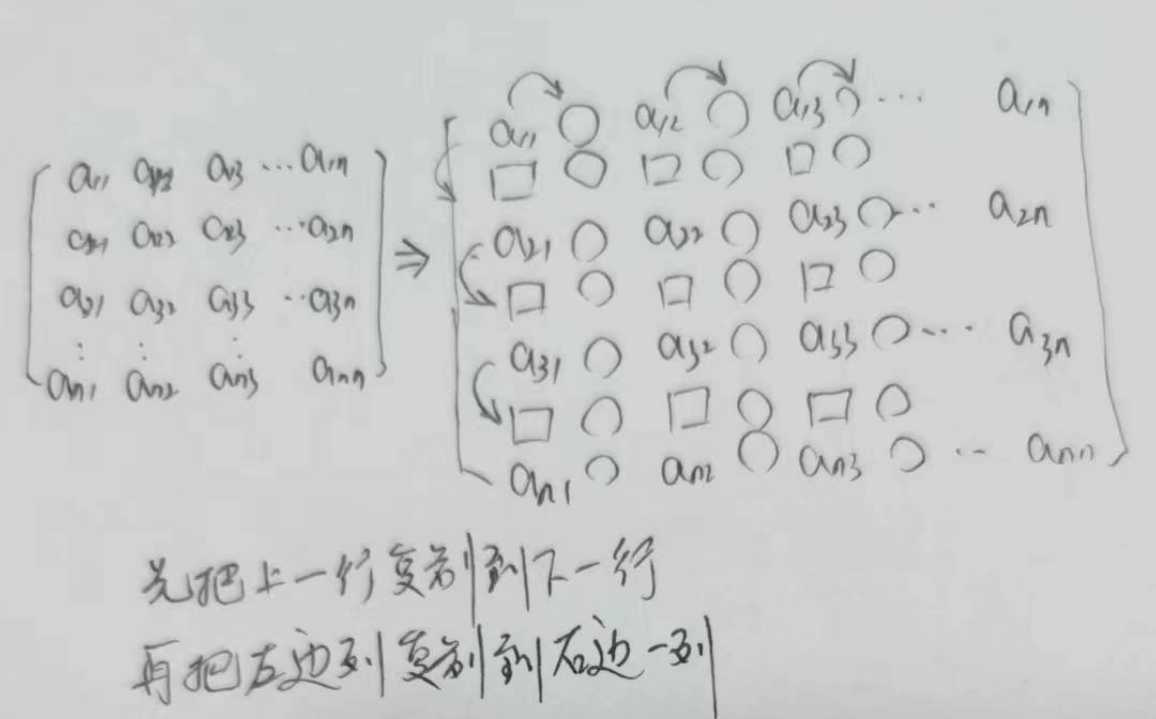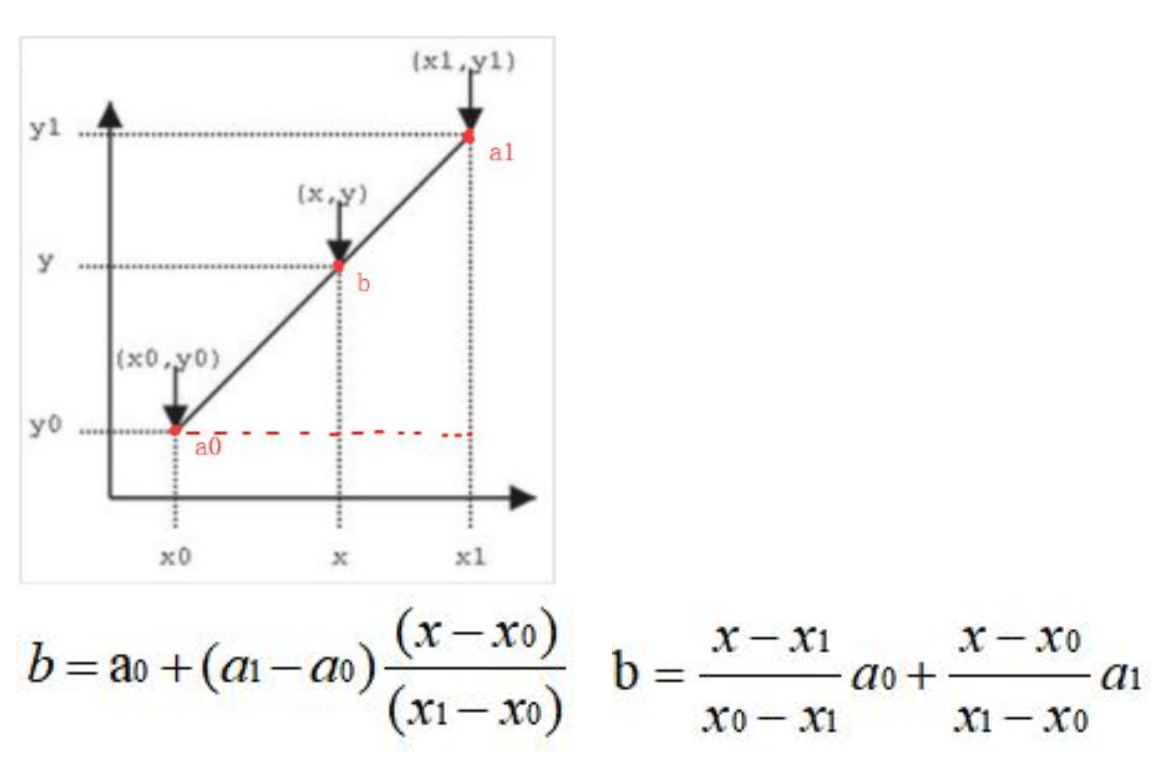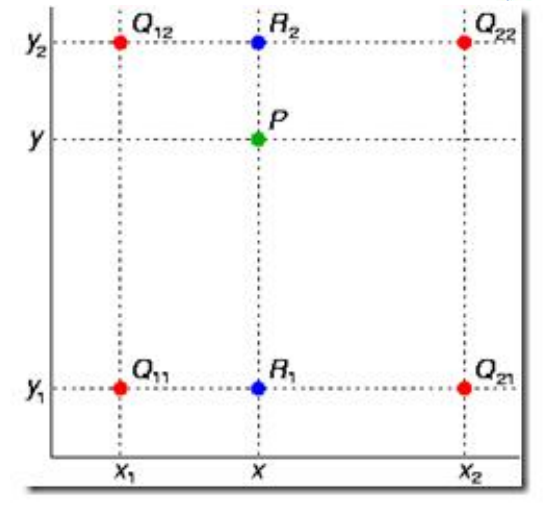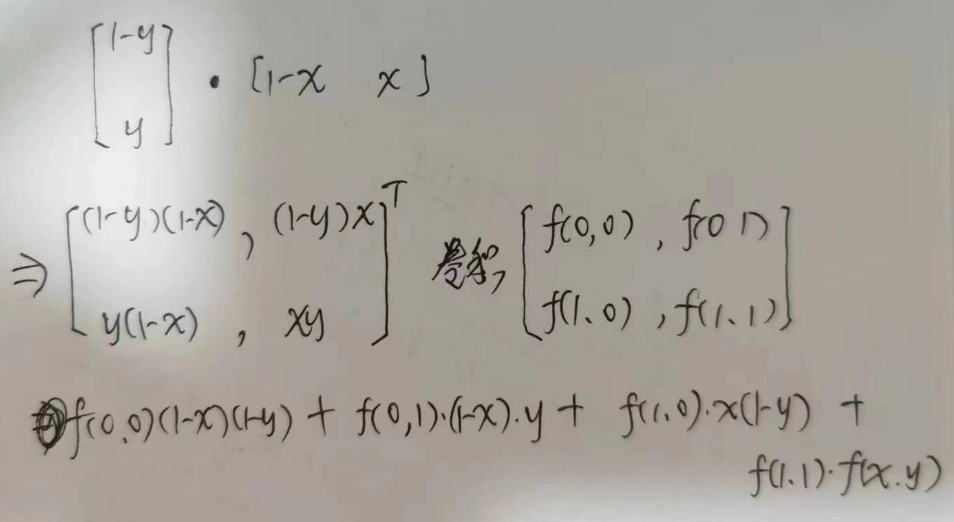深度学习-卷积神经网络--上采样 转置卷积-58
上采样
1. copy实现

2. 线性差值

又称为双线性内插。在数学上,双线性插值是有两个变量的插值函数的线性插值扩展,
其核心思想是在两个方向分别进行一次线性插值
双线性差值

首先在 x 方向进行线性插值,得到:

然后在 y 方向进行线性插值,得到

最后得到:

如果选择一个坐标系统使得 f 的四个已知点坐标分别为 (0, 0)、(0, 1)、(1, 0) 和 (1, 1),那么插值公式就可以化简为

矩阵表示:

卷积表示:

3. 转置卷积
参考: https://blog.csdn.net/qq_37541097/article/details/120709865
import tensorflow as tf
import numpy as np
from skimage.io import imread, imshow, show
# 输入:1张图片,尺寸28*28 高宽,通道数3
# x = np.ones((1, 28, 28, 3), dtype=np.float32)
x = imread('./MNIST_data_bak/raw/mnist_train_0.jpg')
imshow(x)
show()
x = x.astype('float32')
x = x[:, :, 0]
x = tf.reshape(x, (1, 28, 28, 1))
# 卷积核尺寸4x4 ,5表输出通道数,3代表输入通道数
# w = np.ones((4, 4, 5, 3), dtype=np.float32)
w = np.ones((4, 4, 1, 1), dtype=np.float32)
# 扩大2倍
output = tf.nn.conv2d_transpose(x, w, (1, 56, 56, 1), [1, 2, 2, 1], padding='SAME')
with tf.Session() as sess:
m = sess.run(output)
print(m.shape)
imshow(m[0, :, :, 0].astype('uint8'))
show()
from tensorflow.examples.tutorials.mnist import input_data
from matplotlib import image
import os
# 读取MNIST数据集。如果不存在会事先下载。
mnist = input_data.read_data_sets("MNIST_data_bak/", one_hot=True)
# 我们把原始图片保存在MNIST_data/raw/文件夹下
# 如果没有这个文件夹会自动创建
save_dir = 'MNIST_data_bak/raw/'
if os.path.exists(save_dir) is False:
os.makedirs(save_dir)
# 保存前20张图片
for i in range(20):
# 请注意,mnist.train.images[i, :]就表示第i张图片(序号从0开始)
image_array = mnist.train.images[i, :]
# TensorFlow中的MNIST图片是一个784维的向量,我们重新把它还原为28x28维的图像。
image_array = image_array.reshape(28, 28)
# 保存文件的格式为 mnist_train_0.jpg, mnist_train_1.jpg, ... ,mnist_train_19.jpg
filename = save_dir + 'mnist_train_%d.jpg' % i
# 将image_array保存为图片
# 先用scipy.misc.toimage转换为图像,再调用save直接保存。
# scipy.misc.toimage(image_array, cmin=0.0, cmax=1.0).save(filename) #已弃用
image.imsave(filename, image_array, cmap='gray') # 存成三个通道
print('Please check: %s ' % save_dir)
import tensorflow as tf
import numpy as np
from skimage.io import imshow, imread, show
def produce_image():
ori_image = imread('./MNIST_data_bak/raw/mnist_train_0.jpg')
print(type(ori_image))
print(ori_image.shape)
imshow(ori_image)
show()
return ori_image[:, :, 0] # 只取一个通道
def upsample_filt(size):
'''
生成一个 size*size的方阵 中心点值为1
[[0.11111111 0.22222222 0.33333333 0.22222222 0.11111111]
[0.22222222 0.44444444 0.66666667 0.44444444 0.22222222]
[0.33333333 0.66666667 1. 0.66666667 0.33333333]
[0.22222222 0.44444444 0.66666667 0.44444444 0.22222222]
[0.11111111 0.22222222 0.33333333 0.22222222 0.11111111]]
:param size:
:return:
'''
factor = (size + 1) // 2 # 宽度的1/2
print('factor: %s' % factor)
if size % 2 == 1:
center = factor - 1
else:
center = factor - 0.5
print('center: %s' % center)
og = np.ogrid[:size, :size]
'''
[array([[0],
[1],
[2],
[3],
[4]]), array([[0, 1, 2, 3, 4]])]
'''
print(og[0])
'''
[[0]
[1]
[2]
[3]
[4]]
'''
print(og[1])
'''
[[0 1 2 3 4]]
'''
y_relate_dist = (1 - abs(og[0] - center) / factor)
print(y_relate_dist) # 竖直方向举例中心的相对距离
'''
[[0.33333333]
[0.66666667]
[1. ]
[0.66666667]
[0.33333333]]
'''
x_relate_dist = (1 - abs(og[1] - center) / factor)
print(x_relate_dist) # 水平方向距离中心的相对距离
'''
[[0.33333333 0.66666667 1. 0.66666667 0.33333333]]
'''
return y_relate_dist * x_relate_dist # 广播后对应位置相乘 二维 相对中心点的距离
# 进行上采样卷积核
def bilinear_upsample_weights(kernel_size, channels):
print('filter_size: %s' % kernel_size)
w = np.zeros((kernel_size, kernel_size,
channels, channels), dtype=np.float32)
upsample_kernel = upsample_filt(kernel_size)
print(upsample_kernel)
for i in range(channels):
w[:, :, i, i] = upsample_kernel
return w
def upsampling_bilinear():
return bilinear_upsample_weights(2, 1)
if __name__ == '__main__':
image = produce_image()
img = tf.cast(image, dtype=tf.float32) # numpy的数据类型转换成 tf.float32
img = tf.reshape(img, (1, 28, 28, 1)) # 扩展成m*h*w*c
# 产生卷积核
kerenel = upsampling_bilinear()
# 反卷积处理
# img: 1*28*28*1 NHWC
# kernel: 2*2*1*1 HW*out_channel*in_channel
# output_shape: the output shape of the deconvolution op.
# strides=[1, 2, 2, 1]
# N H W C 四个方向 NC 一般是1 H-1 W-1为填充0的值的个数 再做stride=1正常的卷积
# HM取2 则会填充1个 --> 原图*2 HM取3 则会填充2个 原图*3 所以HM也就是原图放大的倍数
res = tf.nn.conv2d_transpose(img, kerenel, output_shape=[1, 56, 56, 1], strides=[1, 2, 2, 1], padding='SAME')
with tf.Session() as sess:
img = sess.run(res)
imshow(img[0, :, :, 0].astype('uint8'))
show()

